2013 DODGE CHARGER brake light
[x] Cancel search: brake lightPage 434 of 631
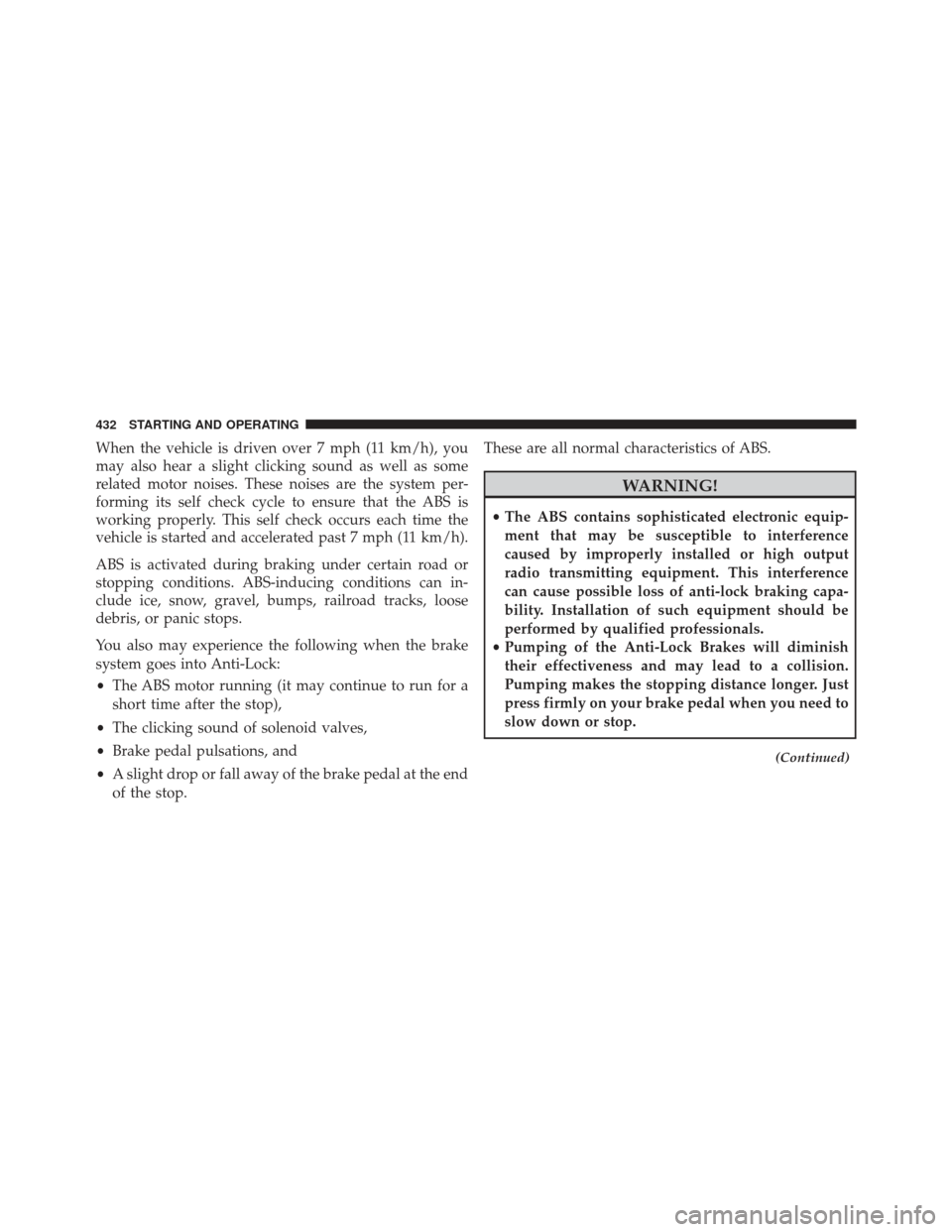
When the vehicle is driven over 7 mph (11 km/h), you
may also hear a slight clicking sound as well as some
related motor noises. These noises are the system per-
forming its self check cycle to ensure that the ABS is
working properly. This self check occurs each time the
vehicle is started and accelerated past 7 mph (11 km/h).
ABS is activated during braking under certain road or
stopping conditions. ABS-inducing conditions can in-
clude ice, snow, gravel, bumps, railroad tracks, loose
debris, or panic stops.
You also may experience the following when the brake
system goes into Anti-Lock:
•The ABS motor running (it may continue to run for a
short time after the stop),
• The clicking sound of solenoid valves,
• Brake pedal pulsations, and
• A slight drop or fall away of the brake pedal at the end
of the stop. These are all normal characteristics of ABS.
WARNING!
•
The ABS contains sophisticated electronic equip-
ment that may be susceptible to interference
caused by improperly installed or high output
radio transmitting equipment. This interference
can cause possible loss of anti-lock braking capa-
bility. Installation of such equipment should be
performed by qualified professionals.
• Pumping of the Anti-Lock Brakes will diminish
their effectiveness and may lead to a collision.
Pumping makes the stopping distance longer. Just
press firmly on your brake pedal when you need to
slow down or stop.
(Continued)
432 STARTING AND OPERATING
Page 440 of 631
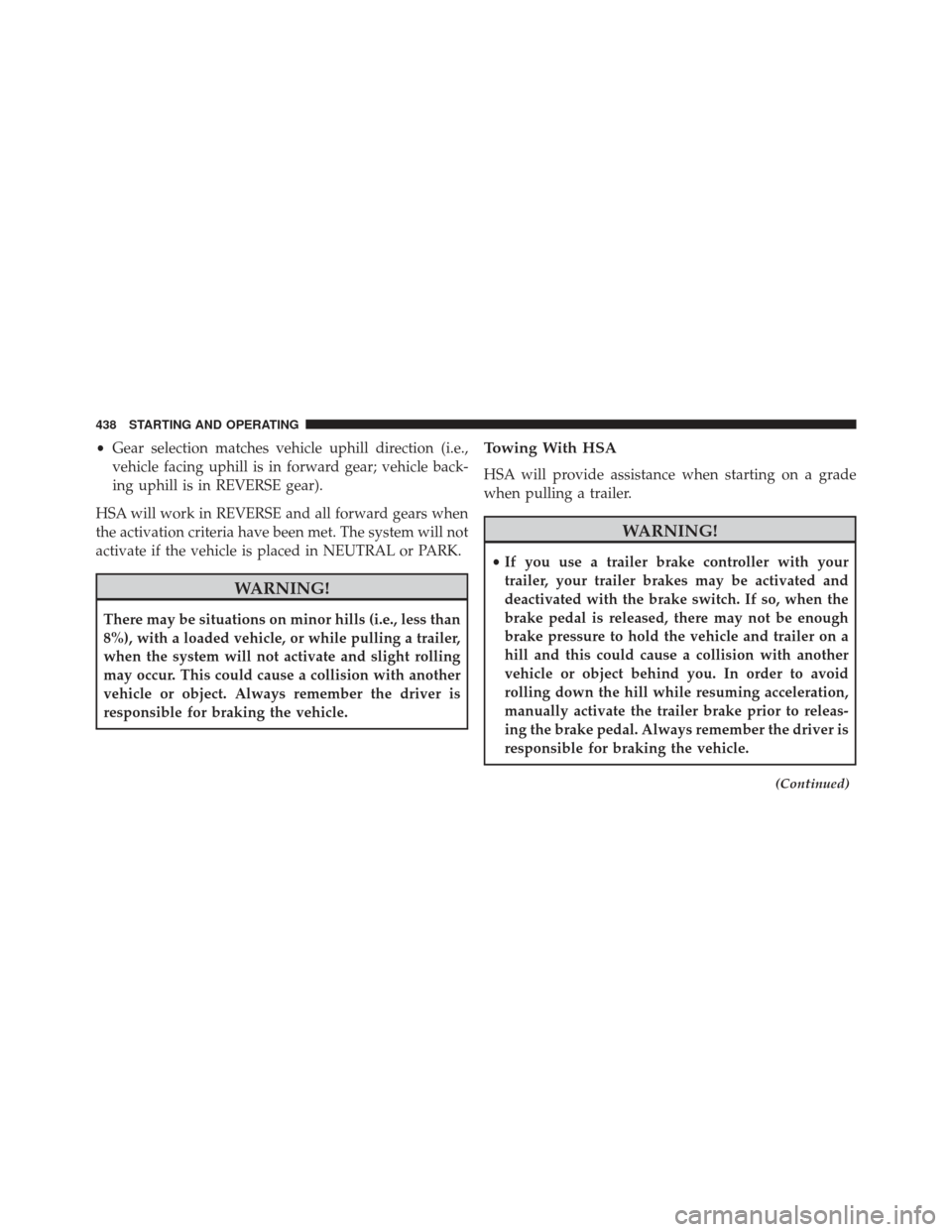
•Gear selection matches vehicle uphill direction (i.e.,
vehicle facing uphill is in forward gear; vehicle back-
ing uphill is in REVERSE gear).
HSA will work in REVERSE and all forward gears when
the activation criteria have been met. The system will not
activate if the vehicle is placed in NEUTRAL or PARK.
WARNING!
There may be situations on minor hills (i.e., less than
8%), with a loaded vehicle, or while pulling a trailer,
when the system will not activate and slight rolling
may occur. This could cause a collision with another
vehicle or object. Always remember the driver is
responsible for braking the vehicle.
Towing With HSA
HSA will provide assistance when starting on a grade
when pulling a trailer.
WARNING!
• If you use a trailer brake controller with your
trailer, your trailer brakes may be activated and
deactivated with the brake switch. If so, when the
brake pedal is released, there may not be enough
brake pressure to hold the vehicle and trailer on a
hill and this could cause a collision with another
vehicle or object behind you. In order to avoid
rolling down the hill while resuming acceleration,
manually activate the trailer brake prior to releas-
ing the brake pedal. Always remember the driver is
responsible for braking the vehicle.
(Continued)
438 STARTING AND OPERATING
Page 503 of 631
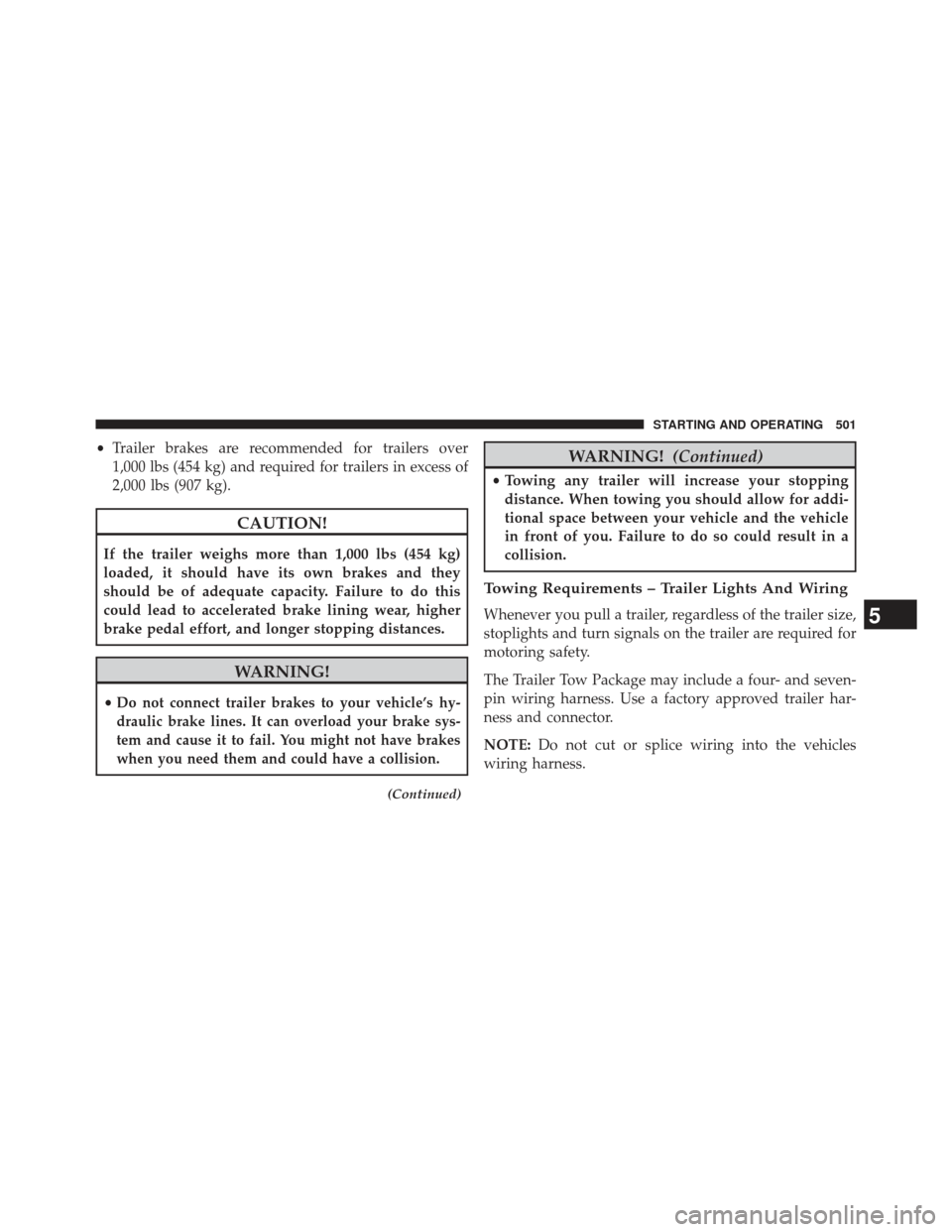
•Trailer brakes are recommended for trailers over
1,000 lbs (454 kg) and required for trailers in excess of
2,000 lbs (907 kg).
CAUTION!
If the trailer weighs more than 1,000 lbs (454 kg)
loaded, it should have its own brakes and they
should be of adequate capacity. Failure to do this
could lead to accelerated brake lining wear, higher
brake pedal effort, and longer stopping distances.
WARNING!
•Do not connect trailer brakes to your vehicle’s hy-
draulic brake lines. It can overload your brake sys-
tem and cause it to fail. You might not have brakes
when you need them and could have a collision.
(Continued)
WARNING! (Continued)
•Towing any trailer will increase your stopping
distance. When towing you should allow for addi-
tional space between your vehicle and the vehicle
in front of you. Failure to do so could result in a
collision.
Towing Requirements – Trailer Lights And Wiring
Whenever you pull a trailer, regardless of the trailer size,
stoplights and turn signals on the trailer are required for
motoring safety.
The Trailer Tow Package may include a four- and seven-
pin wiring harness. Use a factory approved trailer har-
ness and connector.
NOTE: Do not cut or splice wiring into the vehicles
wiring harness.5
STARTING AND OPERATING 501
Page 561 of 631
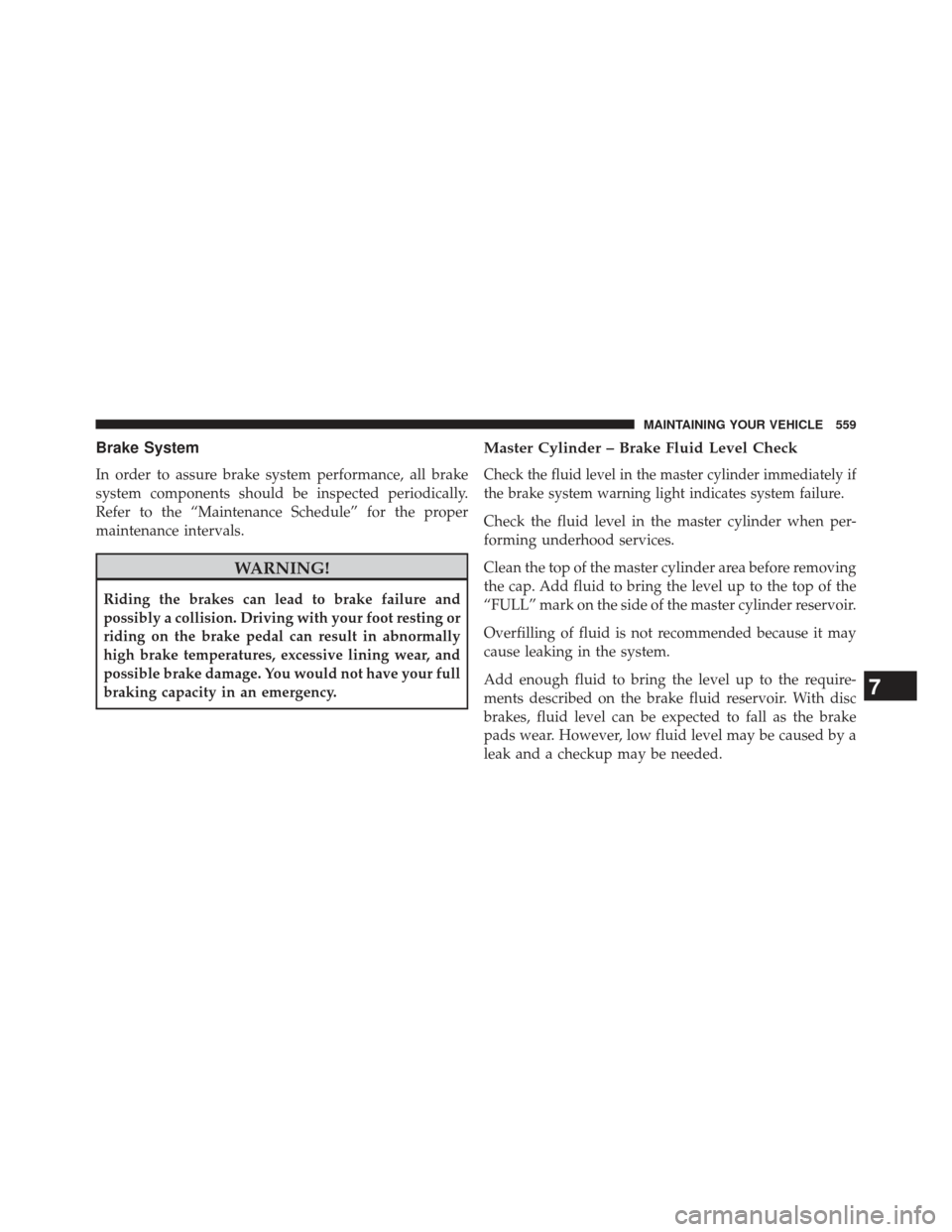
Brake System
In order to assure brake system performance, all brake
system components should be inspected periodically.
Refer to the “Maintenance Schedule” for the proper
maintenance intervals.
WARNING!
Riding the brakes can lead to brake failure and
possibly a collision. Driving with your foot resting or
riding on the brake pedal can result in abnormally
high brake temperatures, excessive lining wear, and
possible brake damage. You would not have your full
braking capacity in an emergency.
Master Cylinder – Brake Fluid Level Check
Check the fluid level in the master cylinder immediately if
the brake system warning light indicates system failure.
Check the fluid level in the master cylinder when per-
forming underhood services.
Clean the top of the master cylinder area before removing
the cap. Add fluid to bring the level up to the top of the
“FULL” mark on the side of the master cylinder reservoir.
Overfilling of fluid is not recommended because it may
cause leaking in the system.
Add enough fluid to bring the level up to the require-
ments described on the brake fluid reservoir. With disc
brakes, fluid level can be expected to fall as the brake
pads wear. However, low fluid level may be caused by a
leak and a checkup may be needed.
7
MAINTAINING YOUR VEHICLE 559
Page 591 of 631
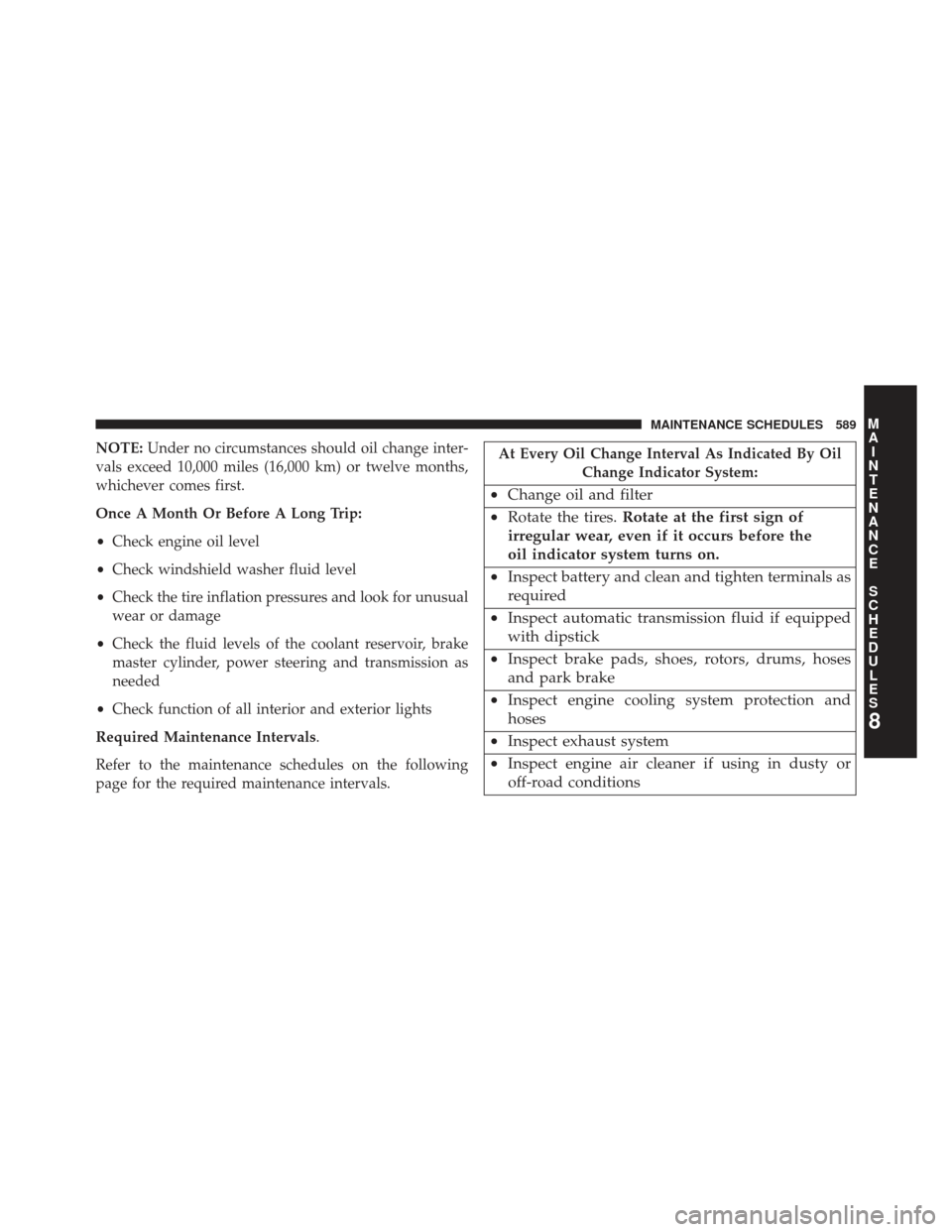
NOTE:Under no circumstances should oil change inter-
vals exceed 10,000 miles (16,000 km) or twelve months,
whichever comes first.
Once A Month Or Before A Long Trip:
• Check engine oil level
• Check windshield washer fluid level
• Check the tire inflation pressures and look for unusual
wear or damage
• Check the fluid levels of the coolant reservoir, brake
master cylinder, power steering and transmission as
needed
• Check function of all interior and exterior lights
Required Maintenance Intervals.
Refer to the maintenance schedules on the following
page for the required maintenance intervals.At Every Oil Change Interval As Indicated By Oil Change Indicator System:
•Change oil and filter
• Rotate the tires. Rotate at the first sign of
irregular wear, even if it occurs before the
oil indicator system turns on.
• Inspect battery and clean and tighten terminals as
required
• Inspect automatic transmission fluid if equipped
with dipstick
• Inspect brake pads, shoes, rotors, drums, hoses
and park brake
• Inspect engine cooling system protection and
hoses
• Inspect exhaust system
• Inspect engine air cleaner if using in dusty or
off-road conditions
8
M
A I
N T
E
N
A
N
C E
S
C
H E
D
U L
E
SMAINTENANCE SCHEDULES 589
Page 610 of 631

About Your Brakes....................... .429
ABS (Anti-Lock Brake System) ................431
Adaptive Cruise Control (ACC) (Cruise Control) . . .244
Adding Engine Coolant (Antifreeze) ............555
Adding Fuel ............................ .486
Adding Washer Fluid ..................... .550
Additives, Fuel .......................... .479
Adjustable Pedals ........................ .238
Airbag ..................................60
Airbag Deployment ........................71
Airbag Light .............................68
Airbag Maintenance ........................73
Airbag, Side ..............................63
Airbag, Window (Side Curtain) ................64
Air Cleaner, Engine (Engine Air Cleaner Filter) . . . .543
Air Conditioner Maintenance .................546
Air Conditioning Filter .....................387
Air Conditioning, Operating Tips ..............388
Air Conditioning Refrigerant .................546Air Conditioning System
....................384
Air Pressure, Tires ........................ .453
Alarm Light ............................ .322
Alarm, Panic .............................24
Alarm (Security Alarm) ......................18
Alarm System (Security Alarm) ................18
All Wheel Drive (AWD) .....................423
Alterations/Modifications, Vehicle ...............7
Antifreeze (Engine Coolant) ..................554
Disposal ............................. .557
Anti-Lock Brake System (ABS) ................431
Anti-Lock Warning Light ....................321
Anti-Theft Security Alarm (Theft Alarm) ..........18
Appearance Care ........................ .564
Arming Theft System (Security Alarm) ...........18
Assist, Hill Start ......................... .437
Auto Down Power Windows ..................41
Automatic Dimming Mirror ..................110
Automatic Door Locks ......................33
608 INDEX
Page 611 of 631

Automatic Headlights..................... .220
Automatic Oil Change Indicator ...............334
Automatic Temperature Control (ATC) ..........384
Automatic Transmission ....................402
Adding Fluid ......................... .563
Autostick ............................ .418
Fluid and Filter Changes ..................563
Fluid Change ......................... .563
Fluid Level Check ...................... .561
Fluid Type ........................... .561
Special Additives ...................... .562
Automatic Transmission Limp Home Mode .......410
Autostick .............................. .418
Auto Unlock, Doors ........................33
Auto Up Power Windows ....................41
Axle Fluid ............................. .586
Axle Lubrication (Axle Fluid) .................586Battery
................................ .544
Keyless Transmitter Replacement (RKE) ........25
Location ............................. .544
Belts, Seat ...............................49
Body Mechanism Lubrication .................549
B-Pillar Location ......................... .448
Brake Assist System ...................... .434
Brake Control System, Electronic ..............433
Brake Fluid ............................ .586
Brake, Parking .......................... .429
Brake System ........................... .559
Anti-Lock (ABS) ....................... .431
Fluid Check .......................... .559
Master Cylinder ....................... .559
Parking ............................. .429
Warning Light ........................ .322
Brake/Transmission Interlock .................401
10
INDEX 609
Page 616 of 631
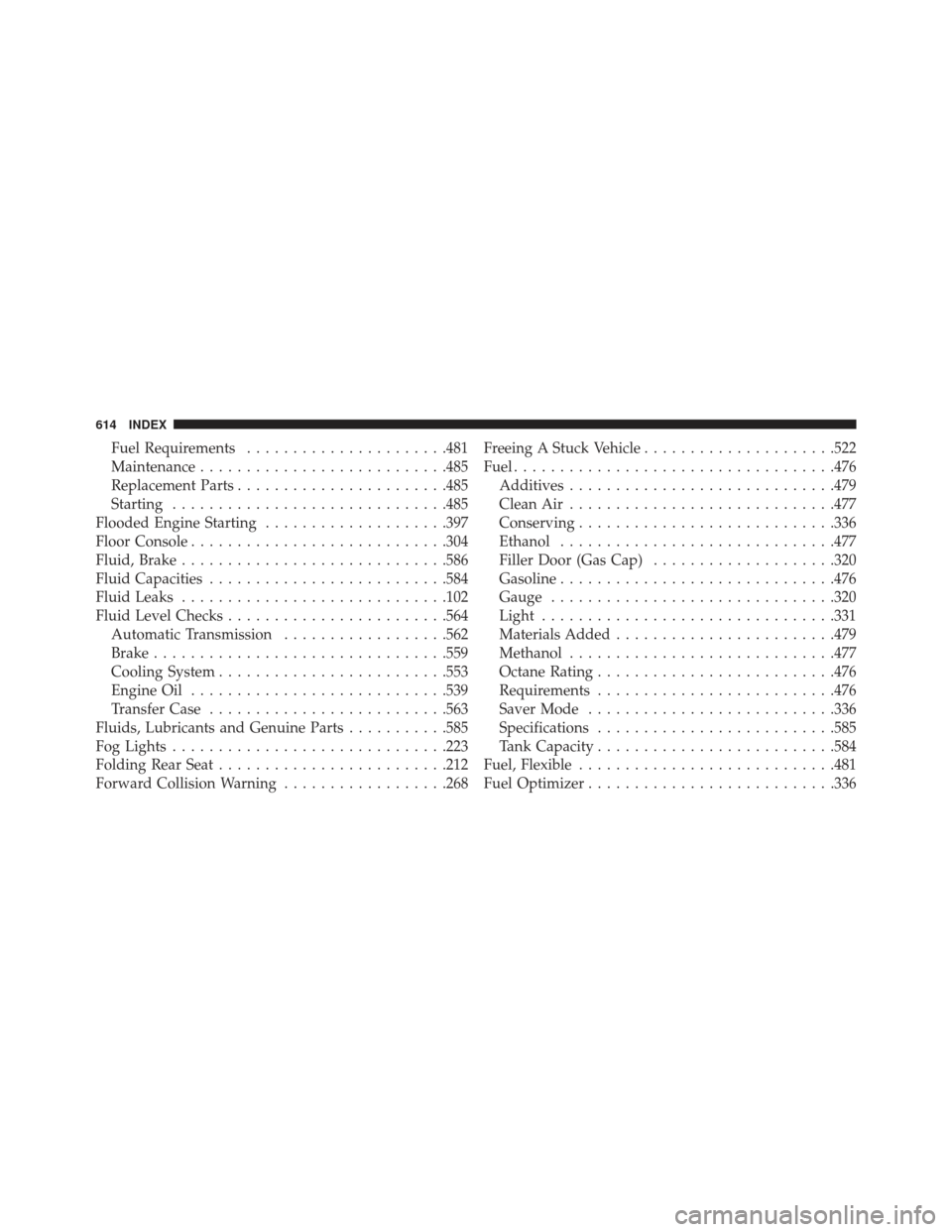
Fuel Requirements..................... .481
Maintenance .......................... .485
Replacement Parts ...................... .485
Starting ............................. .485
Flooded Engine Starting ....................397
Floor Console ........................... .304
Fluid, Brake ............................ .586
Fluid Capacities ......................... .584
Fluid Leaks ............................ .102
Fluid Level Checks ....................... .564
Automatic Transmission ..................562
Brake ............................... .559
Cooling System ........................ .553
Engine Oil ........................... .539
Transfer Case ......................... .563
Fluids, Lubricants and Genuine Parts ...........585
Fog Lights ............................. .223
Folding Rear Seat ........................ .212
Forward Collision Warning ..................268 Freeing A Stuck Vehicle
.....................522
Fuel .................................. .476
Additives ............................ .479
Clean Air ............................ .477
Conserving ........................... .336
Ethanol ............................. .477
Filler Door (Gas Cap) ....................320
Gasoline ............................. .476
Gauge .............................. .320
Light ............................... .331
Materials Added ....................... .479
Methanol ............................ .477
Octane Rating ......................... .476
Requirements ......................... .476
Saver Mode .......................... .336
Specifications ......................... .585
T
ank Capacity ......................... .584
Fuel, Flexible ........................... .481
Fuel Optimizer .......................... .336
614 INDEX